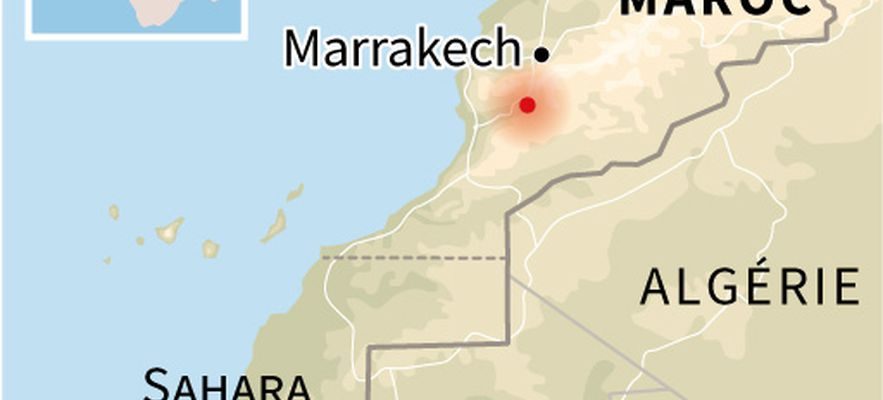The results are still provisional: at least 632 people died in a powerful earthquake which struck Morocco during the night from Friday to Saturday. The victims were recorded “in the provinces and communes of Al-Haouz, Marrakech, Ouarzazate, Azilal, Chichaoua and Taroudant”, the ministry said in a press release. In addition, 329 people were injured, including 51 in serious condition.
The National Center for Scientific and Technical Research (CNRST), based in Rabat, indicated that the earthquake had a magnitude of 7 degrees on the Richter scale and that its epicenter was located in the province of Al-Haouz , southwest of the city Marrakech, a popular destination for foreign tourists.
According to Moroccan media, this is the most powerful earthquake to hit the kingdom to date. According to images reproduced by the media, on social networks and by witnesses, the earthquake caused significant damage in several cities. Images showed part of a minaret collapsed in the famous Jemaa el-Fna square, the beating heart of Marrakech, leaving two people injured.
An AFP correspondent saw hundreds of people flocking to this emblematic square of the ocher city to spend the night, for fear of aftershocks. Some had blankets, others slept on the ground. “We were walking in Jemaa el-Fna when the earth started to shake, it was a truly astonishing sensation. We are safe and sound but I am still in shock. I have at least ten members of my family who are died in Ijoukak (rural commune of Al-Haouz, Editor’s note). I find it hard to believe it because it was not more than two days ago that I was with them,” Houda Outassaf, a city resident met on the square.
Location map of the epicenter of the earthquake which struck Morocco during the night from Friday to Saturday.
© / AFP
“Lucky to be alive”
Mimi Theobald, a 25-year-old English tourist, was about to have dessert on the terrace of a restaurant with friends “when the tables started to shake, the dishes started to fly, we panicked. […] Afterwards, we tried to go to our hotel to collect our luggage and passports because our flight was scheduled for tomorrow but it was impossible because our hotel is located in the medina. There was debris everywhere, it wasn’t very safe. This is the first time that we have witnessed an earthquake. When the adrenaline wore off, we realized that we were very lucky to still be alive,” she adds.
In addition to Marrakech, the tremor was felt in Rabat, Casablanca, Agadir and Essaouira, causing panic among the population. Many people took to the streets of these cities, fearing the collapse of their homes, according to images posted on social networks. In photos and videos published by Internet users, we can see significant debris of homes in the alleys of the Marrakech medina. But also cars crushed by stones.
“I was in my bed when everything started shaking. I thought my bed was going to fly away. I went out into the street half naked and immediately went to see my riads. was total chaos, a real catastrophe, madness,” Frenchman Michaël Bizet, 43, owner of three traditional houses in the old town of Marrakech, told AFP by telephone.
“Screams and cries”
The regional blood transfusion center in Marrakech called on residents to come to its premises this Saturday to donate blood for the injured. “We had the impression that it was a river that was overflowing violently. The screams and tears were unbearable,” says another resident of the city, Fayssal Badour, 58 years old.
Indian Prime Minister Narendra Modi, host of the G20 summit meeting this weekend in New Delhi, sent his condolences to the relatives of the victims of the earthquake, saying in a message on loss of life.” German Chancellor Olaf Scholz also sent a message of condolences after this “devastating” earthquake, citing “terrible news from Morocco”.
The country has already experienced other similar situations in the past. On February 24, 2004, an earthquake measuring 6.3 degrees on the Richter scale shook the province of Al Hoceima, 400 kilometers northeast of Rabat, killing 628 people and causing significant material damage. And on February 29, 1960, an earthquake destroyed Agadir, on the west coast of the country, and killed more than 12,000 people, or a third of the city’s population.
